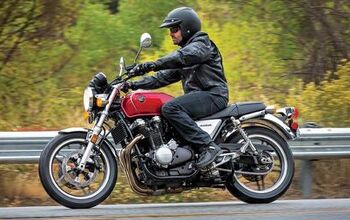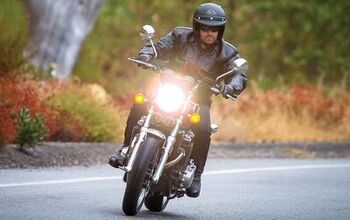The American Culture of Motorcycle Safety
It’s ironic that while our machines are practically one step removed from Star Wars technology, the culture surrounding their use is one step removed from the Wild West.
The American approach to safety for motorcyclists and scooterists – that is, our attitudes and practices – is essentially a world of anything goes; each person must choose amidst a culture fraught with mixed messages and conflicting agendas.
Helmet? No helmet? Full face? Half helmet? Head-to-toe gear? Leather jacket and jeans? Shorts and T-shirt? A little training? A lot? None?
| Allstate Insurance On Rider Safety |
Our friends at Allstate Motorcycle Insurance know a thing or two about motorcycle safety. In addition to Motorcycle.com's safety series, Allstate Motorcycle Insurance has its own valuable safety information to share. * Motorcycle Awareness: Safety Tips from Allstate Motorcycle Insurance |
In 2007 (latest data available), according to the National Highway Traffic Safety Administration (NHTSA), the number of on-road motorcycles registered topped 7.1 million. But while fatalities among other roadway users have declined – particularly auto drivers, which in 2008 recorded the fewest deaths in 47 years – NHTSA contends that motorcyclist fatalities have increased steadily for the past 10 years even when factored for increased registrations.
This is further contrasted to the fact that in nearly every other human endeavor today, people are clamoring for – and basically getting – more and more safety.
You have air bags and other safety devices in cars, protection from pesticides in foods, safety in children’s toys to the point of being ludicrous, such as the lead ban, safety on walkways for shoppers and restaurant-goers, heck, even campaigns to promote safe sex…
But when it comes to powered two wheelers, there are no universally agreed upon standards. None.
Today about 21 states require full-time helmet use and most require eye protection. Other than that, if you want to tour the country on your turbo Hayabusa in a Speedo (or realistically, jeans, T-shirt, no helmet), have at it. Or, if you want to wear head-to-toe armored gear, you can do that too.
Try exercising the first option in Germany.
In America, we call it freedom. And just to be clear: Freedom is great. We all love freedom, and this is no pitch to remove our rights as riders.
But this country’s founders said freedom is a social contract assuming some responsibilities on citizens. One price of freedom is people must agree to do their best to exercise good judgment and do what’s best to improve their quality of life, which is what freedom is supposed to be for. Self-restraint and wise personal choices are supposed to be in place if external laws are not.
These kinds of arguments are what justified our extremely free country in the first place.
As it is, the U.S. is unlike other countries with nationally mandated standards for rider safety. Here each state decides what if any gear is appropriate.
This is what We the People have chosen. But in spite of this, injuries and deaths continue to increase, and a lot of people shake their heads in disbelief.
When I asked Andrea Nalesso, sales marketing manager for Dainese, which country has the least regard for motorcycle safety, he said it’s “very much the U.S., which is the worst among the countries that I know.” In the phone interview, which took place from Indianapolis a year ago, he added, “The United States is the country with the least awareness about safety.”
Nalesso – an Italian who happened to be in the States that week helping Valentino Rossi as his safety gear supplier – travels the world and he’s in the business, so he has some perspective. Nor is he the only person with this view. Many others say the same.
About the only safety measure America has pushed that Germany has not is artificially low speed limits. By catering to the lowest common denominator, this minimizes competence required to get on (and stay on) the road.
Germany also has tiered licensing, which requires you to qualify to ride a big bike, but this will likely never happen here, as long as every state is doing its own thing.
As it is, in the absence of clear standards, motorcyclists and scooterists generally agree that we cannot really agree on much of anything. What we have are different camps, each with their own innate sensibility of acceptable safe practices.
There are extremes too, each pushing opposite agendas. On one hand, you have the ATGATT crowd (all the gear all the time) – usually racers, ex-racers, safety instructors, marketers selling safety gear and services, and others who believe gear is your only protection in a nasty get-off.
On the other extreme are the motorcyclists’ rights organizations, or MROs. These groups – while also made up from experienced riders – have a different take on things.
Since 1975, they have successfully employed grassroots efforts leading to nationwide lobbying techniques to wage campaigns advocating libertarian ideals for riders. They can sometimes come across as the new American patriots.
Their most active advocates have made it a mission of writing editorials, creating fact sheets and assembling statistics to show state legislators and other decision makers why helmet laws should be not universally mandatory for those of adult age (usually 18 or 21).
On the far fringe of this group, some go beyond the neutral message of “let those who ride decide,” and suggest or state outright that crashing with a helmet could be more dangerous than without a helmet.
Yes, there are some who’d like to prove a helmet is often an anti-safety device and are very energetic and determined to do so (and this is putting it politely).
Citing anecdotes and some statistics, such far from center evangelists say helmets could cause a basal skull fracture, or neck snap due to whiplash, or could impair hearing or visibility.
To help preserve our freedoms, arguments against helmet laws have been presented by bikers, who have been known to roar their bikes (some believe loud pipes save lives, after all) to the capitol building to share the information with legislators pending a helmet law repeal vote.
But these folks are not against safety. They just don’t agree – and that is their right – that the helmet is such a major issue. They would much rather talk about avoiding the crashes in the first place.
And that particular argument does have a lot of merit. Drivers are often way too distracted as they send text messages, fiddle with food or makeup, argue with kids as they try to help each child load his or her personal DVD player. What is more, larger, taller vehicles make for nasty body slams, and four-wheel vehicles on average are now bigger than ever…
So absolutely, a large number of motorists are unwitting vehicular homicides waiting to happen. But does that mean a helmet is still not a better bet?
Why would enlightened free citizens even need a law to force them to be safe? Sure, “let those who ride decide.” To whom it applies: How about voluntarily deciding to gear up?
There’s a reason why every powersports race sanctioning body in the U.S. mandates helmets (and full gear) for racers.
There’s a reason why American football players wear a helmet – and full pads. Now granted, football is a contact sport where you are guaranteed to collide.
In motorcycling, you hope you will not make contact. But if you did, how would you want to be dressed?
In any case, what ever your situation, it is a gamble. And like gambling, it’s fun to win, but not fun to lose. If you ever found yourself with multiple fractures, it might change your feelings about your level of risk tolerance.
Which brings us to another topic: Inherent risk.
Motorcycles are a carryover from a time when everyone faced greater risk. In 1899, when motorcycles were in their infancy, we had far less effective healthcare and medicine, and no insurance. Our lives were altogether less secure and there was practically no one you could sue.
And while in nearly every other arena security has since improved, motorcycles can only be so safe. Honda, BMW, and others are experimenting with airbags and improved ABS, but you’ll probably never see a crash cage on a motorcycle.
This is the risk you accept. This is reality. You are a 21st century person enjoying a 21st century version of a 19th century experience.
And for some risk takers, the perverse or interesting thing – you decide – is that it’s a blast to get away with flirting with disaster. Researchers have found brain chemistry for die-hard risk takers (such as dopamine levels) is amped up while taking chances, and they live for the rush.
In contrast, there is another element in society that does not quite see it the way we do: those in favor of safety legislation.
Some are known to ask: If a rider splats himself on the highway, racks up huge medical bills, and becomes dependent on the state, why should society have to pay?
And, they ask, is it fair that individual rights take precedence over the rights of the many? If a rider was breaking the law when he went down, that is all the more egregious to people of this mindset.
These people do not look at motorcyclists as enlightened citizens enjoying their rights as free men and women. They see the effects of some adults acting like adolescents, not taking all reasonable precautions. They see an unruly group that needs to be controlled.
Their arguments take on further legitimacy because they mirror the reasoning that’s already been used to push other safety legislation – such as seatbelt usage – into existence.
The back and forth rhetoric gets a fresh rehash every time a local rider dies without a helmet, and some editorialist spouts off about how stupid riders are for not using one.
If a big enough splash happens, it has been known to help tip the scales, such as when Gary Busey suffered brain damage in 1988, and in 1992 California went back to being a helmet state.
Today, the debate has become a public relations battle, and the holy grail of rights is to go without a helmet, particularly by MRO advocates in front of lawmakers. And frankly, I mostly agree with the MROs; a person should have the right, as long as they do not cost other people.
To me, the real question however is what is smart? What level of risk are you willing to take, and have you thought it all the way through? If carrying a passenger, have you explained it to him or her so they can make informed decisions?
Motorcycling is often a pursuit of passion, not always guided by strictly rational, logical thinking. A lot of riders will not bother with gear simply because it seems too expensive, too hot, too inconvenient, or not in style with their crowd.
And this lackadaisical attitude doesn’t just apply to safety gear and helmets, but also to training.
Getting properly trained, taking refresher courses, or at least proactively doing your own practice drills is a great idea. Simply riding does not prepare you as well for accident avoidance.
But, objectively speaking, how can we really know what’s safer? Is there any science behind these opinions?
Some research has been done. About 10 years ago, the Europeans did the comprehensive MAIDS study, and there is the 1981 “Hurt Report” (Motorcycle Accident Cause Factors and Identification of Countermeasures).
This year, even though Harry Hurt says his findings are still basically valid, the first American “motorcycle crash causation study” since 1981 was intended to begin forensically examining 900 motorcycle accidents over a three-year period.
To fund the study, in 2006 Congress promised a whopping $2.5 million. In 2007, the motorcycle community came up with their part of the deal pledging $3 million. And by the time it was ready to start, costs were estimated at $8-10 million. So it has gone nowhere.
The per-American expenditure to shed further light on saving lives – at a time when motorcyclist numbers were peaking along with their incidences of death and injury – was astonishingly low.
In their defense, some say the feds – which in any case found billions to bail out corrupt insurance industry execs and mismanaged businesses – offered too little only because the motorcycle community underestimated the costs.
Further the motorcycle community “stakeholders” had within its ranks those not exactly gushing with enthusiasm. There were some who, A) said they doubted the study could get quality data, and B) did not want to see more data confirming ideas that could threaten their lifestyle – such as findings that a full-face helmet (as Hurt already demonstrated) was absolutely a better idea.
So where do things stand today? The U.S. culture of motorcycle safety, while seeing some terrific innovations in gear and training, exists in a largely unregulated environment where some riders disagree with and contradict other riders regarding best safe practices.
But while it may be like the Wild West, if you get trained, continue to train throughout your motorcycling career, wear the best gear you can, honestly assess your risk – and use your freedom wisely – you can be like the hero who wins the gunfight, instead of one of the hapless characters who gets shot down.
Related Reading
How Well Do You Know Your Motorcycle?
Rider Education, Injuries and Fatalities
What to Wear When You Ride - and Why
The SEE System: Increasing Your Visibility
Motorcycle Insurance Basics
Choose a Motorcycle That Fits
Group Riding 101
Should You Ride a Motorcycle
How to Load Your Motorcycle
Night Riding
Riding With a Passenger
Riding in the Rain and Wind
The Truth about Drinking and Riding
Road Conditions Quiz
Knowing How to Brake Saves (the most) Lives
More by Jeff Cobb



























Comments
Join the conversation